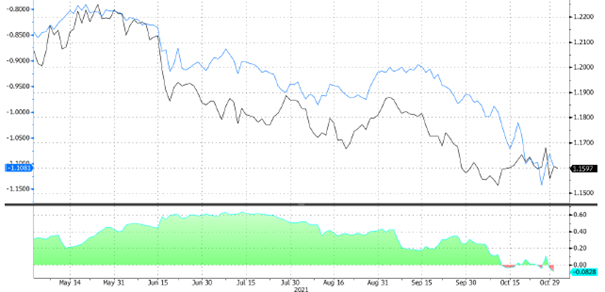
Is inflation out of control?
26 October 2021
Rates: A Lift-Off Story
9 November 2021INSIGHTS • 2 November 2021
Here we go again

Ali Jaffari, Head of North American Capital Markets
Here we go again, it’s all about the Fed this week. Market participants will be closely watching to see if the Fed will stand ground on its recent messaging. To sum up, at the last meeting the Fed acknowledged substantial progress on the labor market and went on to broadly note that tapering measures would kick-off soon and conclude by mid 2022. Fast forward to today, with inflation levels further elevated and yields rising across the curve, this particular Fed meeting bears greater weight as the market is expecting clear direction via a timeline or pathway on the phase out of the $120B monthly asset purchase program.
Central bank chatter around the globe has been challenged, with the investor community testing the resolve of the ‘transitory inflation’ narrative and upending markets. Following months of rangebound activity, front-end treasury yields have risen across G10 currency pairs, with notable moves seen in Australia, Canada and the UK. This change in market behavior comes as more and more participants shy away from the monotonous central bank inflationary view that’s been keeping rates subdued for an extended period of time.With market forces underway, central banks will no doubt be under pressure to conform. Just last week, the benchmark 3-year yield in Australia surged ~50bps well surpassing the yield curve control target set out by the Reserve Bank of Australia and brought into question the central bank’s policy guidance and the overall need for yield curve control measures. Similarly, a large sell-off seen in UK and Canadian bond markets are driving the Bank of England and Bank of Canada to adapt and pricing expectations are now calling for 3 and 5 rate hikes respectively by the end of 2022. All eyes now turn to the Fed for their forward-looking guidance, on whether a rate hike is actually in the cards for 2022 (currently 60% priced in).
Emerging market (EM) currencies offer a clearer view with respect to the inflation / monetary policy handle. Unlike developed markets, the EM world lacks the opportunity to wait and assess how the inflation story actually unfolds and whether it is transitory in nature. In efforts to protect against market detriments, a number of EM central banks have taken an aggressive stance on hiking rates – notably so, they are outperforming their peers and gaining ground vs the USD. South Korea, Russia and Peru are key examples where proactive tightening cycles have led to currency appreciation, even through the month of October where front-end US yields almost doubled.
Despite the steady increase in US rates, USD has underperformed the majors over the last month. The Fed is now a laggard amongst central banks, with respect to its tapering and hiking cycle and barring a hawkish Fed, the trend seems set to continue. Although the Fed has made it clear that they’re going to begin tapering asset purchases, the market is expecting clarity on the pace of its reductions and further to that, endorsement of the rate hike that is currently baked in.
Even with heightened market activity and price action picking up across asset classes (as seen in treasuries), volatility in FX remains diminished and trading ranges in major currency pairs are yet at multi-decade lows. It’s as if the market is awaiting some sort of catalyst to drive it out of its shell, part of which could be central bank guidance. The growing deviation between the Fed and the market however is in part what needs to be addressed for USD pairs to break out of its lull.
As seen in Chart 1, interest rate differentials (yield spread) in EUR/USD have been a key driver for the currency pair with correlation in a 40% – 60% range. As of late however, the correlation of yield spreads to the pair have been fairly muted and hovering around near zero levels despite more pronounced moves in yields. This disconnect could be brushed aside as temporal in nature, and perhaps it may subside as the Fed regains its credibility in the market, but it is not without its risks. The pressure on currency markets is undoubtedly rising, and should the stability become undone it could have dire effects across asset classes.
Chart 1: EURUSD (blue) vs 2Y Yield Spread EU – US (black), Correlation

Source: Bloomberg
Keep an eye out for the Fed narrative this week, and how the market digests its tapering plan and forward guidance on the next lift-off in interest rates. As the Fed looks to address its divergence to other central banks and react to the recent movement in yields, be prepared for the potential of heightened volatility and its rising impact on hedging costs.
Be the first to know
Subscribe to our newsletter to receive exclusive Validus Insights and industry updates.



